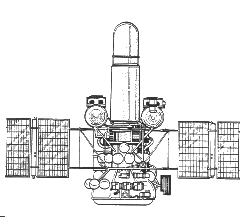
The Soviet Astron orbital station was designed primarily for UV and X-ray
astrophysical observations. It was injected into orbit on 23 March 1983.
The satellite was put into a highly elliptical orbit, with apogee ~200,000 km
and perigee ~ 2,000 km. The orbit kept the craft far away from the Earth
for 3.5 out of every 4 days. It was outside of the Earth's shadow and
radiation belts for 90% of the time. The spacecraft was over 6m long, and
its main instrument was Soviet-French 5m long UV telescope. The station
ceased function in June 1989, well past its expected one year mission
lifetime.
The second major experiment aboard Astron was an X-ray spectrometer. The
experiment, SKR-02M, consisted of a proportional counter sensitive to
2-25 keV X-rays, with an effective area of 0.17 sq-m. The field of view
was 3 degrees x 3 degrees (FWHM). Data could be telemetered in 10 energy
channels. The instrument began taking data on 3 April 1983.
This experiment provided data on the prolonged low state of
Her X-1 in 1983, and the 1984 turn on of the source. It also observed
sources in Orion, Taurus, and Leo. The investigation of accretion of
material from red giants to neutron stars was specifically targeted.